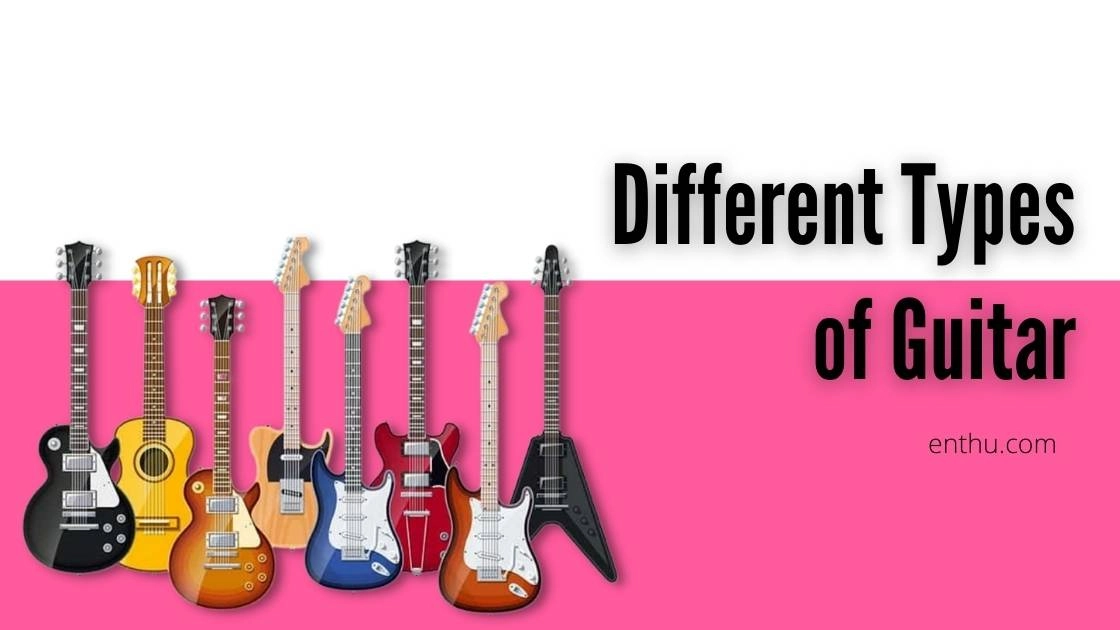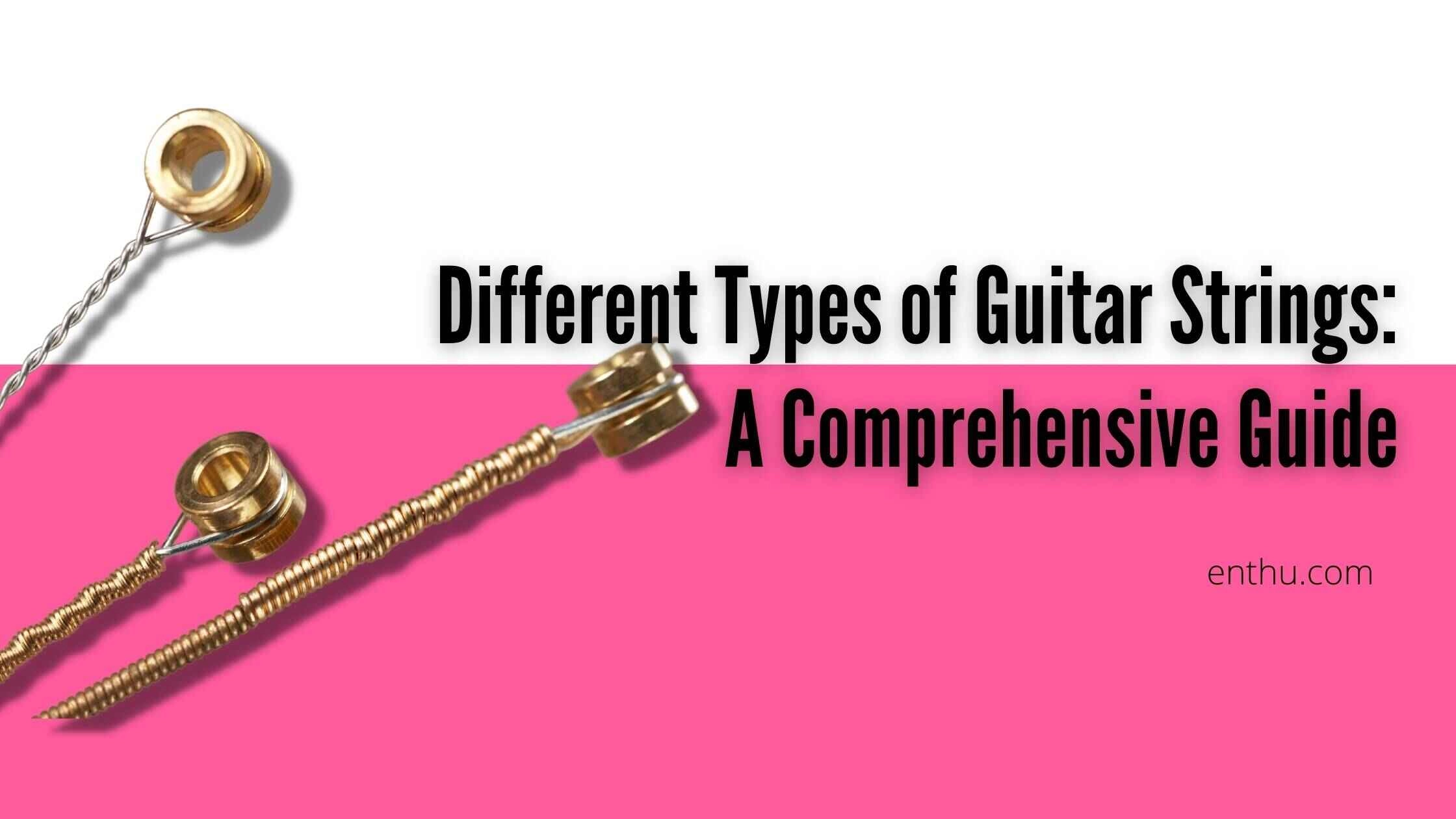Strings are the vocal chord of a guitar, don't you agree? Try playing a guitar without the strings, and you will know what I mean. Once you buy a guitar for the first time and you notice some rust, you will definitely get nervous!
I know it is hard to choose the right string from all the different guitar string types, but a clear idea about the types will help you buy the right ones consciously.

Guitars - According
Their Strings Guitars are amazing, not only because of the beautiful tunes but also for the variety it offers. Did you know that there are various kinds of guitars based only on the numbers and types of the strings? Yeah, I am amazed as well. Staring from 4 strings and going up to 12 strings make guitars unique and offer an amazing range to choose from.
1. Four String Guitar/Bass
Bass guitar is the most underrated of all types, but it is the backbone of any musical piece; pick any Rock & Roll song, for instance.
Bass guitars come with 4 strings tuned in E, A, D, and G notes. These guitars come with a visible narrow, and unusually long fretboard. However, modern-day bass guitars come with five to six strings as well.


2. Six String Guitar
This is the most popular type of guitar. A six-string acoustic or electric guitar is tuned to the following

notes: E, A, D, G, B, and E. The pitches of the strings are as follows: E2, A2, D3, G3, B3, and E4. Usually, this tuning pattern is widely accepted throughout the world and considered the standard tuning.

3. Seven-Eight String Guitar
If you are a fan of metal or progressive music, the chances are high that you have seen seven or eight-string guitars.
Iconic guitarists Jeff Loomis and Stephen Carpenter play 8 string guitars frequently for their music. These guitars usually come with the standard tuning of 6-string guitars but with two extra pitches under the E2 pitch.

4. Twelve String Guitar
Did you know George Harrison played a twelve-string guitar for his iconic song 'My Sweet Lord'? Well, yes, twelve-string guitars are commonly associated with simple folk or country music.
The tuning is rather interesting in these guitars as the strings are tuned in doubled pitches (both in octaves and unison).


Types of Electric Guitar Strings
The strings of an electric guitar and electric bass are fundamentally different from the strings of an acoustic guitar. Essentially, the former is made of various metals.
When plucked, these strings create vibration, and the dedicated pickups convert the vibration into electrical signals and transmit it through an amplifier. Electric guitar strings are generally made of three types of metals:

1. Nickel String Since
The inception of the modern electric guitar around the 1930s, nickel has been one of the primary metals to make the strings.
These strings are perfect for guitarists who prefer a vintage tone and mellow reverb from their guitar. Nickel strings create an edgier and clear sound than steel strings. However, these strings are not as durable as steel strings.
2. Steel String
This is the most economical option for electric guitarists, as the steel strings last longer than strings made of any other materials. Also, if you hate the squeaky sound of the strings while sliding your fingers on the fretboard, these are the best choice for you.

The sound of steel strings is remarkably clear and sharp. Although, you should be careful while choosing the right pickup, as the bright tone of these strings might neutralize the bright sound.
3. Nickel-Plated Steel
String Nickel-plated steel strings are the most popular strings these days. From beginners to professionals, you will find every kind of guitarist using these strings nowadays. The best thing about nickel-plated strings is that they offer distinct sharp tones like pure nickel strings as well as great flexibility like steel strings.

Types of Acoustic Guitar
Strings Unlike electric guitars and bass guitars, acoustic guitars offer a wide range of materials when it comes to strings. For example, jazz guitars, classical guitars, and Spanish guitars ideally use different strings to create a distinctive sound and tonal balance.

1. Nylon String
Have you ever heard the beautiful compositions of the great Chet Atkins? If yes, you are familiar with the sound of nylon strings. From Cat Stevens and Leonard Cohen to the modern YouTube sensation Estas Tonne, many guitarists have embraced the nylon strings for their guitars.
These strings add a smooth yet edgy effect to the tunes. In fact, this is one of the most popular acoustic guitar string choices among all the variants.
2. Catgut String
Not to get deceived by the names, but catgut strings are actually made of sheep intestine. Sometimes, the intestines of other animals are used too for making catgut strings.
Did you know that catgut strings are the oldest strings for guitars? Yes, these strings have been used for centuries. Read the history of the guitar to learn such amazing facts about the guitar.

These strings are long gone from the music scenario, but you can still find a pair or two in vintage guitar shops.
3. 80/20 Bronze String
These are probably the most popular version of guitar strings, and obviously for the right reasons. The 80/20 bronze strings are versatile and suitable for any acoustic guitar.
Mostly, these strings are used by classical guitarists as the bottom three strings, combined with steel or phosphor bronze strings. However, folk and country musicians use these extensively for their acoustic guitars.
4. Phosphor Bronze String
These strings are updated versions of the popular 80/20 bronze strings. These strings use a phosphor coating over the bronze material, as the name suggests.
This magical component makes the strings durable; however, it significantly reduces the natural shine of the strings. Phosphor bronze strings are immensely popular among artists who move around for concerts frequently.
5. Silver Plated Copper String
These strings come with a silver-plated copper coating over the nylon base. Nylon and silver-plated copper strings are commonly used for the first three strings of a classical guitar.
6. Steel and Silk String
Another variation of the famous nylon string, silk strings are made with nylon or silk base and coated with steel.
Again, these are popular choices for the 1st, 2nd, and 3rd strings on a classical or Spanish guitar. If you want to create a 'mellow' effect with your guitar, these are the strings you should choose.


What is Guitar String Gauge?
Simply put, the diameter or thickness of a guitar string is called the string gauge of a guitar string. It is measured in 1/1000th of an inch.
Types of Guitar String Gauges Do you know why an electric guitar sounds so different from an acoustic one? Well, the answer is the gauge of the strings. Professional guitarists actually change and modify their string gauges according to their requirements.
Usually, thick strings are better for strumming, and thin strings offer excellent results for fingerpicking. Here are the most popular types of string gauges:
1. Extra Light Electric Guitar
0.009 or 0.008 gauge Acoustic Guitar: 0.010 to 0.047 gauge The 0.008 gauge electric guitar strings are also called 'custom-light' strings. Extra light strings are suitable for beginners as they offer excellent playability. However, these strings tend to break easily.
2. Light Electric Guitar
0.012 to 0.053 gauge Acoustic Guitar: 0.010 to 0.046 gauge Naturally, these strings are more durable than extra light ones. Light strings also offer a pleasing tonal effect and a balanced pitch.
3. Heavy Electric Guitar
starts at 0.014 gauge Acoustic guitar: starts at 0.012 gauge This string type is extremely popular among Jazz and Blues musicians. Famous guitarist and Nirvana frontman Kurt Cobain used heavy strings extensively and tuned it to half step-down. These stings offer more maneuverability and more sustain than other types of strings.
Winding Types of Guitar Strings
There are basically three types of winding available on guitars - flatwound, roundwound, and halfwound.
1. Flatwound String
As the name suggests, these strings come with a flat and smooth surface. Highly popular among Blues and Jazz guitarists, these stings offer an easily recognizable undertone. However, these stings are not compatible with Rock or Metal songs, as flatwound strings are hard and don't allow you to play fast-paced compositions.

2. Roundwound String
If you are a classical or Spanish acoustic guitar player, then the chances are that you have been playing roundwound strings all along. These strings are flat yet slightly textured and offer excellent tonal balance. Roundwound strings are preferred by classical, Rock, Metal, and freestyle guitarists.
3. Halfwound String
This is a dark horse among guitar strings. Jokes apart, these strings are the least used strings among all three. The unusual texture and sound make it less approachable. However, many bassists are embracing these strings nowadays for the bright tone. Also, these strings are very expensive, making them a far shot for amateurs or beginners.
4. The Core of the String
The core of the string simply means the shape of the major material of the string. The main two types of string cores are hex core and round core. Hex core strings offer louder and brighter sounds.
These strings became immensely popular in the Rock and Roll and Metal genre for their distinctive sound. However, many guitarists have claimed that these strings are a bit stiff. On the other hand, round core strings offer a smooth tone making them perfect for Blues and Country music.



Conclusion
I hope you have got a comprehensive idea about guitar strings. The days of calling a friend for a string suggestion are over; now, you can choose the best string for your guitar according to your requirements. If you are still confused about which one to buy, check out the best guitar strings for your guitar. Play, break the string, repeat, and reach perfection. Stay with music!

FAQs
1. What kind of guitar strings should I use?
It actually depends on your usage. If you are playing a classical guitar, you should use nylon strings and if you are an electric guitarist, go for steel strings. I would suggest you buy round core strings, as they offer more flexibility.
2. Is playing an electric guitar easier than playing an acoustic guitar?
Yes, playing an electric guitar is easier than playing an acoustic guitar. The strings of an acoustic guitar are placed way higher than the fretboard, making it hard to press and pluck them. In contrast, electric guitars are relatively easier to play from that point.
3. What are some reliable brands for guitar strings?
There are many good guitar string brands available on the market. If you are a beginner, you should go for D'Addario strings as they are cheap and durable. Ernie Ball strings are best for professional guitarists.


Comments